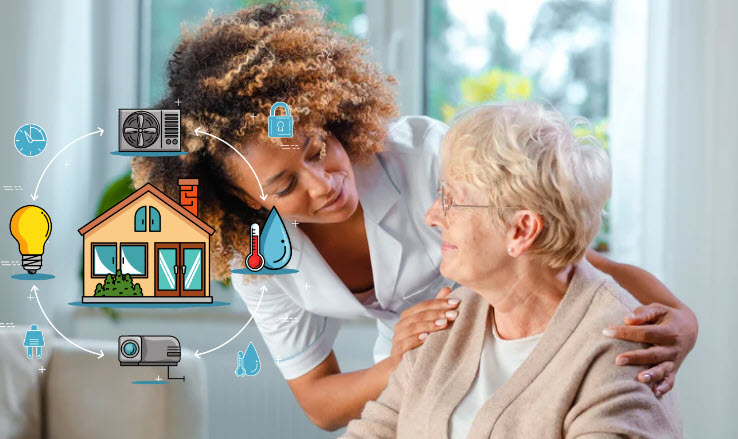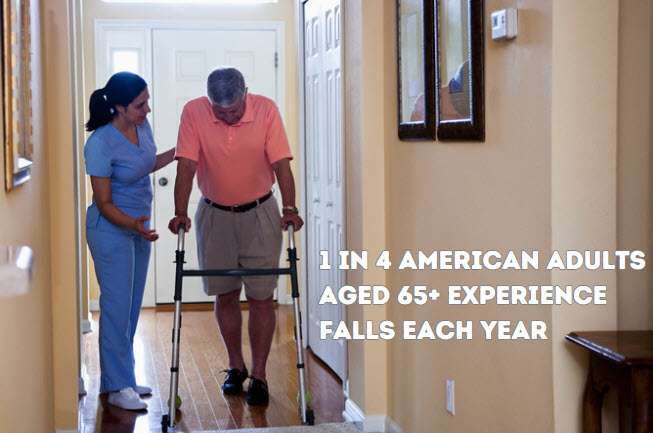The healthcare industry has undergone significant changes and advancements over the years, making it more intricate and multifaceted. This trend shows no signs of slowing down; it appears to be gaining momentum with each passing day. Unfortunately, this complexity can pose a challenge for many older adults suffering from chronic health issues requiring specialized care and support to live an optimal life.
Consequently, seniors often struggle to navigate a maze of medical specialists, treatment options, prescription drugs—and even conflicting clinical opinions—to manage their conditions effectively. Considering these challenging circumstances faced by our elderly population makes one wonder – how is it humanly possible for them to keep up with everything?

The good news is that the increasing use of data in healthcare provides a viable solution to improve healthcare for seniors. Thanks to emerging technologies like the Internet of Things and sensor values connected with telecommunications, healthcare professionals can gather real-time data about patients’ health conditions. This approach is especially crucial for seniors who require tailored healthcare to manage chronic or age-related illnesses. However, the benefits of data go beyond simple information gathering. Data-driven healthcare can also reduce costs and improve patient compliance by empowering seniors to play an active role in their well-being. With the advent of smart technology solutions, a global society could provide senior citizens with better quality healthcare services.
Data on Senior Fall Injuries
One of the most significant and concerning health risks that seniors face is fall injuries. The Centers for Disease Control (CDC) estimates that 1 in 4 adults 65+ experience falling that might cause debilitating injuries. That’s about 26 million people, leading to the death of 32,000 people. However, data can help mitigate this issue. By leveraging home-based technologies, patients can access medical care and counseling from the comfort of their homes, reducing the risk of falls that is particularly high during hospital or doctor visits.
Technology solutions that utilize data have been developed to improve fall risk. In a literature review study conducted on the effectiveness of assistive technologies applied to seniors, sensory technology was identified as one such solution. This type of technology can detect falls in real-time by using sensors that trigger alarms when any unusual movement is detected. Moreover, remote health monitoring solutions have also been found to reduce the risk of falls and improve senior safety. By implementing these assistive technologies and using data to monitor seniors’ health conditions, healthcare professionals gain valuable insights that can help them diagnose problems early before they escalate.
Climbing metal stairs can become impossible for seniors who are at risk of falling, while handicap ramps can be a solution in an assisted home. When someone is frail or has mobility issues, accidents can happen. However, with the help of smart technology, seniors can safely navigate their homes and surroundings. A home equipped with sensors can detect environmental hazards, such as wet floors or poor lighting conditions, that may lead to falls. Additionally, wearable sensors that monitor vital signs and functional movements can also detect any abnormalities that may increase the risk of injuries.
With the help of data-driven technology solutions and assistive devices, seniors can continue to live independently. For instance, cutting-edge technology like wearable sensors can monitor seniors’ vital signs and detect changes in their health. This information can then be transmitted remotely to healthcare providers, giving them valuable insights into their patient’s health conditions and enabling them to identify potential issues before they are admitted to emergency rooms. In addition to detecting falls, data can also help healthcare providers understand the root causes of fall injuries in seniors.
How Data on Healthcare on Track to Make Seniors Safer
As the population of seniors in the United States continues to grow, we must find innovative ways to improve healthcare for this demographic. Luckily, technology solutions that utilize data are making it possible to help seniors live independently while mitigating health risks.
Sensory technology has emerged as an effective solution to detect falls in real time. By using sensors that trigger alarms when any unusual movement is detected, this technology can significantly increase system reliability. Wearable sensors that monitor vital signs and functional movements can also help detect abnormalities that may lead to injuries.
Furthermore, remote health monitoring through mobile devices has made healthcare more accessible and convenient for seniors, allowing them to receive care from the comfort of their homes.
In recent years, many remote health monitoring technologies have emerged that can potentially improve and transform senior healthcare. These cutting-edge technologies respond swiftly in emergencies and are equipped with advanced sensors that can detect potential hazards such as falls or dangerous environmental conditions. This means seniors can receive assistance without even having to trigger an alarm, thanks to innovative sensor technology employed within their homes.
Among these assistive devices are wearable light gadgets imbued with temperature-sensing capabilities. These types of aid make it easier for healthcare professionals to offer prompt responses during medical emergencies faced by older adults. Alzheimer’s patients benefit from telemedicine systems armed with urinary continence and fall prevention sensors; this helps enhance the overall quality-of-care services provided for aging citizens.
Although there is no fool-proof solution when it comes to falling detection or prevention methods, many experts believe using various sensor technologies together increases its reliability significantly – giving elderly people more assurance about their safety while living independently at home for extended periods.
The Ministry of Industry, Tourism, and Commerce created a reliable system funded by a European agency based in Spain, which serves as an excellent example of field-tested remote health monitoring programs providing top-notch care service to senior citizens.

Evidence shows increased demand from senior citizens for personalized wellness managers like smart home solutions, video surveillance equipment designed to ensure safety, fall detection systems, and remote health monitoring tools. Researchers believe these technologies can potentially reduce the number of visits to clinics and hospitals, thereby promoting independence in aging populations. Here are other cutting-edge technologies that can also improve senior healthcare:
- Wearable Devices: Gadgets like smartwatches, fitness trackers, and smart clothing can continuously monitor vital signs such as heart rate, blood pressure, and oxygen saturation. Some wearables also have fall detection and alert capabilities, which can be crucial for the safety of older individuals.
- Remote Patient Monitoring (RPM) Systems: These systems often involve a suite of home devices, like blood pressure monitors, glucometers, and weight scales, that transmit data to healthcare providers. This allows for tracking chronic conditions and immediate response to any alarming changes.
- Telemedicine Platforms: Technologies enabling video consultations with healthcare providers have become increasingly sophisticated, allowing for virtual check-ups and evaluations. Some platforms even support the remote monitoring of health parameters.
- Smart Home Technologies: Devices such as smart speakers and home security systems can be adapted to monitor a person’s daily activities, send reminders for medication, or alert emergency services if needed.
- AI and Machine Learning Algorithms: These can analyze data from the technologies above to predict health events, like a potential fall or exacerbation of the chronic disease, and to personalize healthcare.
- Implantable Monitors: Devices can be implanted into the body to continually monitor conditions like heart arrhythmias or glucose levels in real-time. These devices can transmit information directly to healthcare providers.
- Digital Therapeutics: Software that can provide cognitive behavioral therapies or manage conditions like chronic pain, mental health disorders, etc. These can be personalized to the patient’s condition.
These technologies have the potential to significantly improve senior healthcare by promoting independence, enhancing the ability to manage chronic conditions, and enabling early detection and intervention in acute health issues. However, it’s important to keep in mind that technology implementation should also consider user-friendliness and accessibility for seniors. Moreover, these technologies can help address issues related to the growing costs of healthcare for seniors in the US.
In conclusion, the use of technology in senior healthcare has become increasingly crucial. These innovative solutions can significantly impact common age-related issues such as chronic diseases, fall risk, social isolation, and depression. With remote patient monitoring systems, telemedicine platforms, smart home technologies, AI and machine learning algorithms, implantable monitors, and digital therapeutics available to seniors today, efficient quality care is more accessible than ever before. By leveraging these powerful tools combined with traditional health services, healthcare providers are better equipped to ensure aging Americans receive affordable care that enhances independence and overall well-being while reducing hospitalization or emergency visits costs.

